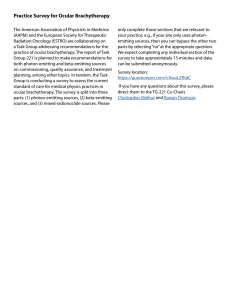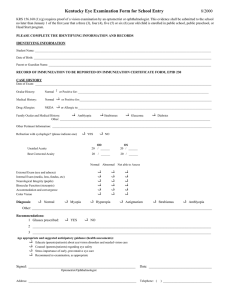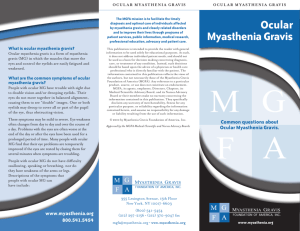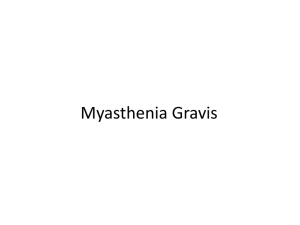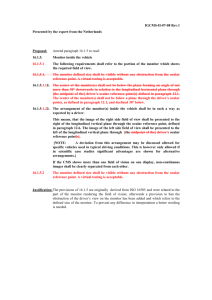Ocular Myasthenia Gravis - Myasthenia Gravis Association of
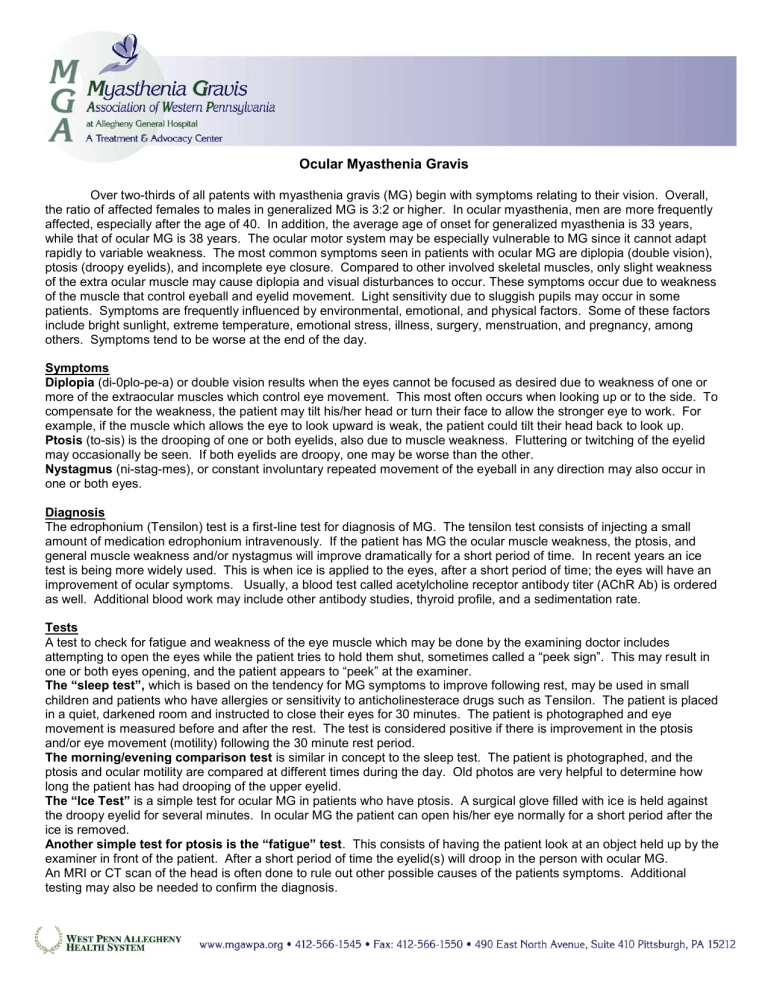
Ocular Myasthenia Gravis
Over two-thirds of all patents with myasthenia gravis (MG) begin with symptoms relating to their vision. Overall, the ratio of affected females to males in generalized MG is 3:2 or higher. In ocular myasthenia, men are more frequently affected, especially after the age of 40. In addition, the average age of onset for generalized myasthenia is 33 years, while that of ocular MG is 38 years. The ocular motor system may be especially vulnerable to MG since it cannot adapt rapidly to variable weakness. The most common symptoms seen in patients with ocular MG are diplopia (double vision), ptosis (droopy eyelids), and incomplete eye closure. Compared to other involved skeletal muscles, only slight weakness of the extra ocular muscle may cause diplopia and visual disturbances to occur. These symptoms occur due to weakness of the muscle that control eyeball and eyelid movement. Light sensitivity due to sluggish pupils may occur in some patients. Symptoms are frequently influenced by environmental, emotional, and physical factors. Some of these factors include bright sunlight, extreme temperature, emotional stress, illness, surgery, menstruation, and pregnancy, among others. Symptoms tend to be worse at the end of the day.
Symptoms
Diplopia (di-0plo-pe-a) or double vision results when the eyes cannot be focused as desired due to weakness of one or more of the extraocular muscles which control eye movement. This most often occurs when looking up or to the side. To compensate for the weakness, the patient may tilt his/her head or turn their face to allow the stronger eye to work. For example, if the muscle which allows the eye to look upward is weak, the patient could tilt their head back to look up.
Ptosis (to-sis) is the drooping of one or both eyelids, also due to muscle weakness. Fluttering or twitching of the eyelid may occasionally be seen. If both eyelids are droopy, one may be worse than the other.
Nystagmus (ni-stag-mes), or constant involuntary repeated movement of the eyeball in any direction may also occur in one or both eyes.
Diagnosis
The edrophonium (Tensilon) test is a first-line test for diagnosis of MG. The tensilon test consists of injecting a small amount of medication edrophonium intravenously. If the patient has MG the ocular muscle weakness, the ptosis, and general muscle weakness and/or nystagmus will improve dramatically for a short period of time. In recent years an ice test is being more widely used. This is when ice is applied to the eyes, after a short period of time; the eyes will have an improvement of ocular symptoms. Usually, a blood test called acetylcholine receptor antibody titer (AChR Ab) is ordered as well. Additional blood work may include other antibody studies, thyroid profile, and a sedimentation rate.
Tests
A test to check for fatigue and weakness of the eye muscle which may be done by the examining doctor includes attempting to open the eyes while the patient tries to hold them shut, sometimes called a “peek sign”. This may result in one or both eyes opening, and the patient appears to “peek” at the examiner.
The “sleep test”, which is based on the tendency for MG symptoms to improve following rest, may be used in small children and patients who have allergies or sensitivity to anticholinesterace drugs such as Tensilon. The patient is placed in a quiet, darkened room and instructed to close their eyes for 30 minutes. The patient is photographed and eye movement is measured before and after the rest. The test is considered positive if there is improvement in the ptosis and/or eye movement (motility) following the 30 minute rest period.
The morning/evening comparison test is similar in concept to the sleep test. The patient is photographed, and the ptosis and ocular motility are compared at different times during the day. Old photos are very helpful to determine how long the patient has had drooping of the upper eyelid.
The “Ice Test” is a simple test for ocular MG in patients who have ptosis. A surgical glove filled with ice is held against the droopy eyelid for several minutes. In ocular MG the patient can open his/her eye normally for a short period after the ice is removed.
Another simple test for ptosis is the “fatigue” test . This consists of having the patient look at an object held up by the examiner in front of the patient. After a short period of time the eyelid(s) will droop in the person with ocular MG.
An MRI or CT scan of the head is often done to rule out other possible causes of the patients symptoms. Additional testing may also be needed to confirm the diagnosis.
Treatment
Both ocular and generalized myasthenia gravis patients tend to have remissions and exacerbations at regular intervals, so that the medications that are used for treatment may need to be changed accordingly. Medications may include cholinesterase inhibitors such as Mestinon, steroids such as Prednisone, or other immunosuppressants used alone or in combination.In addition to medications, other options which may be used are plasmapheresis, or IVIG therapy.
These treatments offer only a temporary improvement and repeated treatments are necessary to sustain the effect. While thymectomy (removal of the thymus gland) is often recommended for patients with generalized MG, it is rarely used in purely ocular MG unless a thymoma is suspected.
In those people whose ocular myasthenia is not adequately controlled by medicine, several aids are available. In many patients, simply wearing a patch over one eye will eliminate the double vision. The patient may alternate the eye patch from one eye to the other to avoid eye strain. Another method is wearing one contact lens which is opaque (can’t be seen through). This may also be changed periodically from one eye to the other. Ask the ophthalmologist how often this should be done. Special prism glasses may also help to correct double vision in some cases.
When both eyelids droop, taping one eyelid open may improve vision. The use of non-allergenic tape such as paper tape is suggested. Once again, alternating eyelids is recommended to prevent eye strain. Another way to hold one or both eyelids open is to have ptosis bars or eyelid crutches attached to the eyeglasses. These are thin, flexible wires which attach at the bridge of the nose and are free-floating at the other end or attached to the frame near the hinges. The wires rest against the eye socket and hold the eyelid open like a brace or crutch. These devises must be carefully fitted and adjusted by an ophthalmologist. Most patients report that the eyes adjust to the bars after a period of time. And they are much more convenient than taping the lids open. Since the eyes can’t blink normally, dryness and irritation may result. It is important to remove the glasses frequently to allow the eyes to close so that they can be moistened. Some
MG patients have advised that every ten minutes or so is a good guideline. Artificial tear drops and forced blinking may also help. If the patient has double vision in addition to drooping eyelids, one eye should be allowed to close and the other be held up by the ptosis bar. Eyelids can easily be alternated when glasses are removed to allow eyelids to close and be moistened. It is important to remember not to fold these eyeglasses, or carry them in a pocket or purse as the bars bend easily and may cause misalignment. When ptosis does not respond to medication, or conservative treatment, surgery may be suggested to lift the eyelid or lids. Surgery is only done in very rare cases.
Weakness of the muscles that control eye closure (orbicularis oculi) may result in the patient getting soap in their eyes when bathing, and in excessive tearing due to incomplete blinking. The use of non-irritating shampoo, such as baby shampoo, may be of help. Swimming goggles may also be worn when bathing or swimming to prevent eye irritation.
It is important that patents with ocular MG (or generalized MG with ocular symptoms) have their eyes checked regularly. The neurologist or local MG organization may be able to recommend an eye care specialist who is experienced in treating patients with MG. When calling to make an appointment with the ophthalmologist, ask about their experience with treating MG patients, possible costs, and insurance coverage. A call to the patient ’s insurance company to verify that the ophthalmologist participates in their plan and to ask about coverage for special glasses would also be a good idea.
When meeting with the ophthalmologist, it is important to ask questions about how to prevent eye strain, maintaining moisture in the eyes, and how often to alternate the taping or bracing of the eyelids, if applicable.
Additional tips which may help with vision problems include closing the eyes for 30 minutes before going out, to allow the eyes to rest and regain strength. An eye patch may be carried in a pocket or purse to slip on if double vision develops.
Reading or watching TV early in the day or when medication is most effective may also help. However, prolonged use of the eyes is not recommended at any time of the day. Books and magazines may often be purchased in large print versions. The local library or book store may have “books on tape” which can be borrowed for listening. The clinical observations which distinguish ocular myasthenia from generalized MG include: highly restrictive ocular symptoms such as diplopia, ptosis, and weak eye closure. The good news for patients with ocular MG is that if they continue to have only ocular symptoms for three years, there is a very good chance their symptoms will not increase. The use of the above strategies can make it easier to live with ocular MG.
Reviewed for publication by the Medical Advisory Board of the Myasthenia Gravis Association of Western Pennsylvania. 2009
